Introduction
In the rapidly evolving landscape of business operations, Robotic Process Automation (RPA) stands out as a transformative force. The Director of Operations Efficiency faces the daunting task of optimizing processes while maintaining high levels of productivity and accuracy. This article provides a structured roadmap, detailing each critical step to successfully implement RPA and achieve significant operational improvements.
From defining clear objectives and selecting the right tools to developing proof of concept and ensuring robust security measures, these steps offer practical solutions tailored to meet organizational needs. Real-world examples and industry insights illustrate the tangible benefits of automation, highlighting the importance of meticulous planning, continuous improvement, and stakeholder engagement. Dive into this comprehensive guide to unlock the full potential of RPA and drive your organization toward unparalleled efficiency and innovation.
Step 1: Define Objectives and Scope
To implement RPA successfully, begin by clearly defining your objectives and understanding the specific outcomes you aim to achieve. Charting the procedure and identifying stakeholders and systems involved, such as inventory management or online shop software, is crucial. Comparing the complexity and estimated ROI of potential automation candidates can help focus efforts on high-impact areas. Keep in mind, significant immediate successes often arise from automating simple tasks instead of more sophisticated methods.
Consider common use cases like automating identity verification and simple order inquiries, which have proven effective for many companies. For instance, retailers have successfully automated the initial identity verification procedure and basic order status inquiries, such as ‘Where is my order?’.} This approach not only streamlines operations but also increases customer satisfaction.
Defining the extent of your mechanization project will guarantee resources are distributed efficiently. As emphasized by industry experts, utilizing tools such as Tungsten’s automated features can greatly improve process efficiency and customer service. This is reflected in the experience of public service units that adopted innovative technological solutions to transform their operations, capturing much richer detail from invoices and improving overall service delivery.
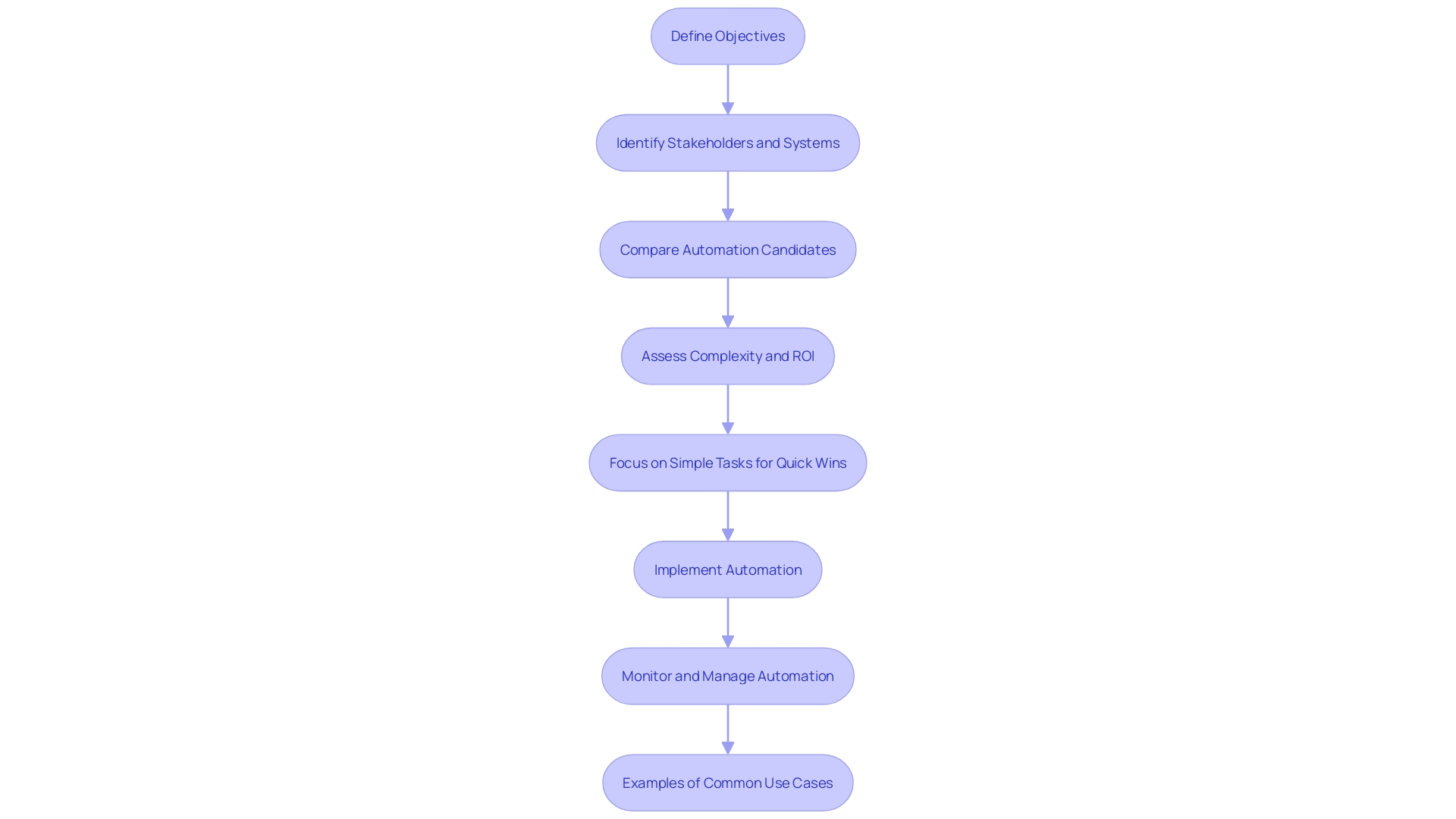
Step 2: Select the Right RPA Tool
Selecting the ideal RPA tool is pivotal for a successful implementation. Start by conducting a thorough evaluation based on your organization’s unique requirements, such as scalability, ease of integration, and vendor support. For instance, many organizations have found that their existing solutions already encompass functionalities they were seeking, emphasizing the importance of diligent assessment. Moreover, the right RPA tool should align with your strategic objectives and ensure it delivers both business and technical value. Keep in mind that automated solutions, whether no-code, low-code, or high-code, should be chosen based on the specific use cases and the technical proficiency of the users. ‘As mechanization continues to be a cornerstone of modern business operations, integrating a well-suited RPA tool can significantly enhance productivity and operational efficiency.’.
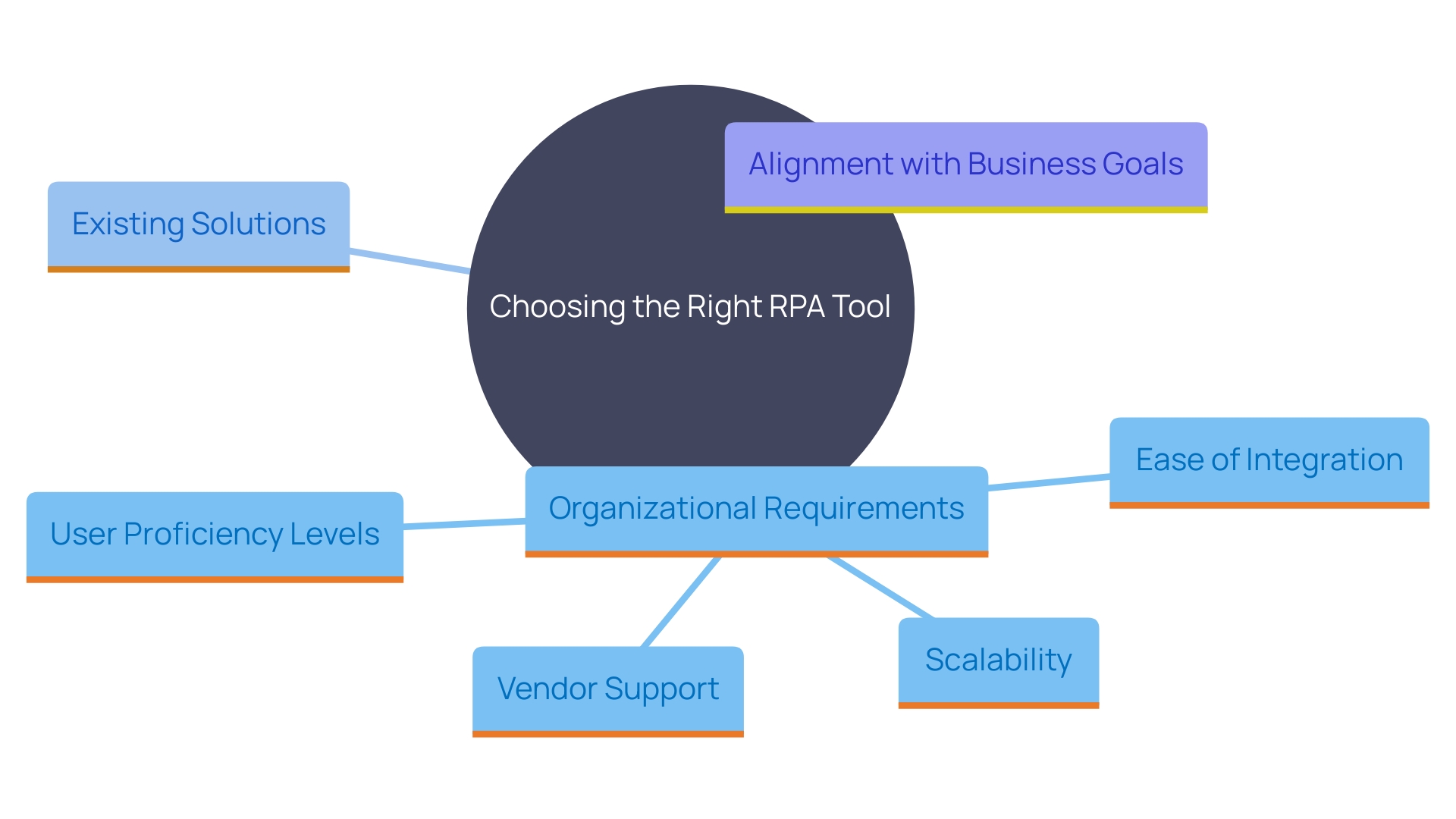
Step 3: Assess Potential Opportunities and Process Analysis
Start with a thorough analysis of your existing methods to identify where mechanization can be most advantageous. Prioritize identifying repetitive tasks that significantly drain time and resources. Documenting workflows is crucial—this allows for a clear understanding of existing procedures and helps highlight inefficiencies. Engage stakeholders to gather insights on pain points, as their perspectives can be invaluable in recognizing areas ripe for improvement.
For instance, Surrey County Council, which serves 1.2 million people, has introduced technology to enhance both citizen and employee experiences. This initiative highlights the significance of thorough examination and stakeholder involvement. Likewise, Specsavers, a worldwide organization with a complicated supply network, has created in-house technologies to tackle particular operational issues, showcasing the benefits of customized mechanization solutions.
Remember, the procedure of integrating automation involves several steps: digitization (converting data into digital form), digitalization (using digital data to modify processes), and digital transformation (leveraging digital technologies to create additional value). Each stage builds on the prior one, enabling a seamless transition from manual to automated systems. As stated, ‘They place technology at the center of end-to-end process execution, allowing humans to focus on providing high-value subject matter expertise.’
By following these steps and leveraging real-world examples, you can effectively implement mechanization to optimize your operations, leading to significant improvements in efficiency and productivity.
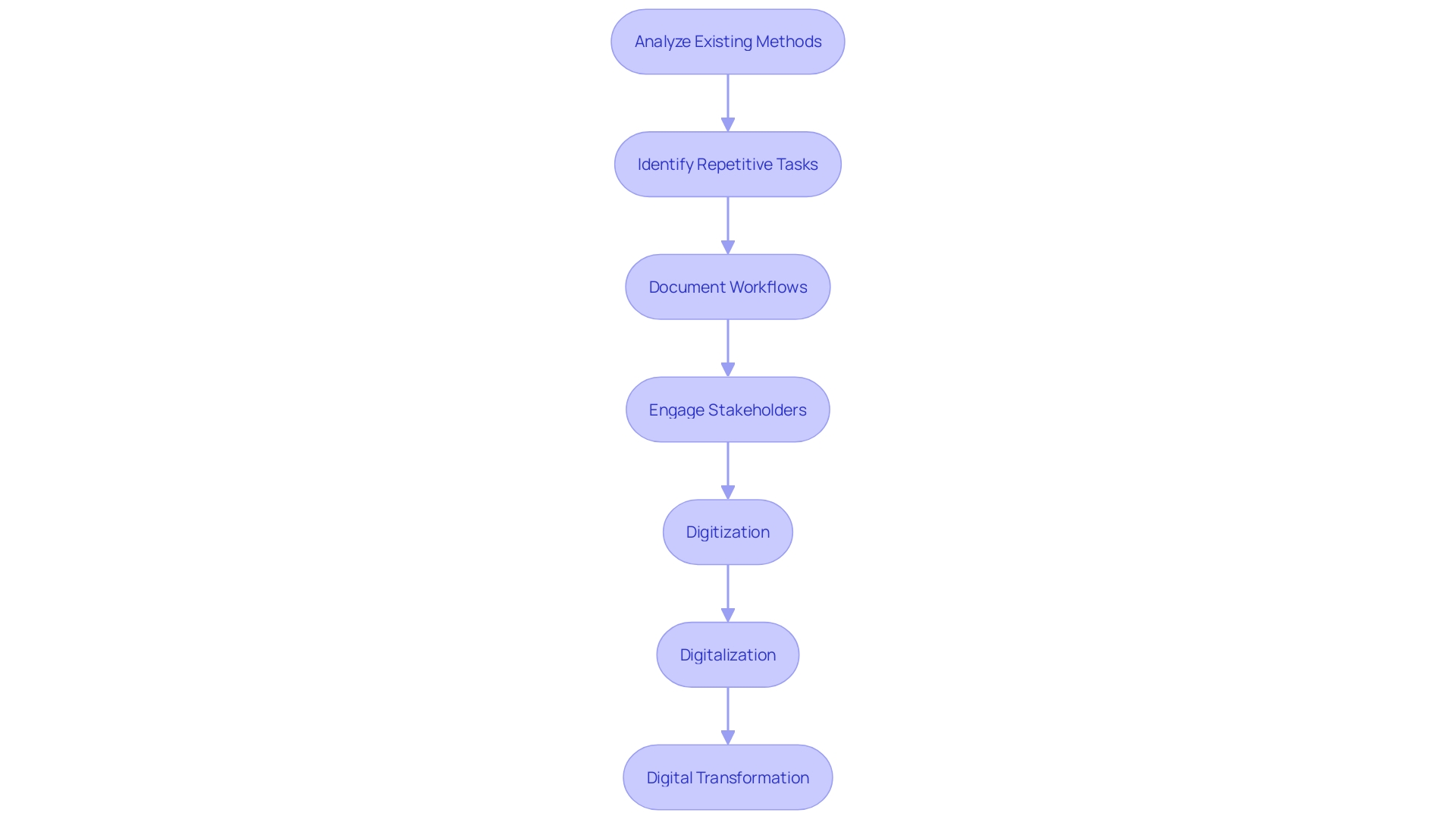
Step 4: Develop Proof of Concept and Pilot Testing
Initiating a proof of concept (PoC) is a crucial step before a full RPA rollout. This pilot phase allows you to test the RPA solution on a smaller scale, ensuring its effectiveness and identifying potential areas for improvement. For example, Millennium Recycling, an industry leader in recycling technology, continually adapts and tests emerging technologies before full implementation. By validating the system through a PoC, you can gather valuable feedback and make necessary adjustments to optimize performance. As emphasized by industry specialists, addressing unmet needs and refining the approach are fundamental to the innovation framework. Therefore, a well-executed PoC not only minimizes risks but also paves the way for successful, full-scale automation deployment.
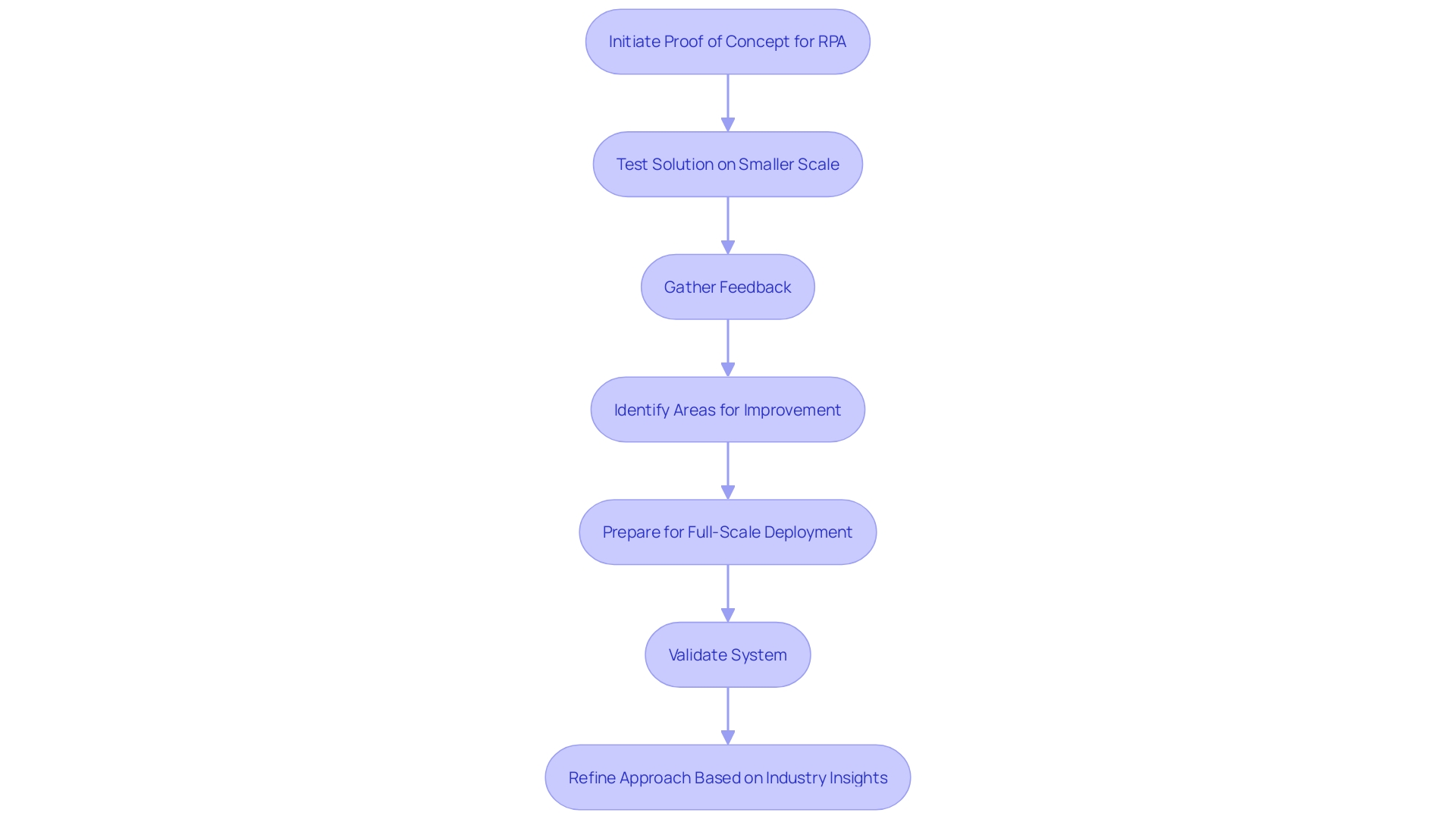
Step 5: Resource Organization and Implementation Planning
Effectively organizing resources is paramount for a successful implementation phase. Begin by crafting a meticulous plan detailing timelines, responsibilities, and necessary resources. Ensure every team member is aligned with their roles and responsibilities.
For instance, Renault’s supply chain digitalization journey offers valuable insights. Between 2018 and 2021, Renault dedicated 10% of its IT budget to data structuring, creating a robust data lake. This structured approach laid the groundwork for developing a control tower, connected with partners like Shippeo, enabling precise factory supply management. As Ludovic Doudard, General Manager Process Engineering Supply Chain at Renault, noted, ‘In the supply chain department, while we have digitized and organized our operations well, our data depends on information systems, it is thus naturally organized.’ This meticulous planning and resource allocation were pivotal in achieving high operational efficiency, showcasing the importance of a well-structured implementation plan.
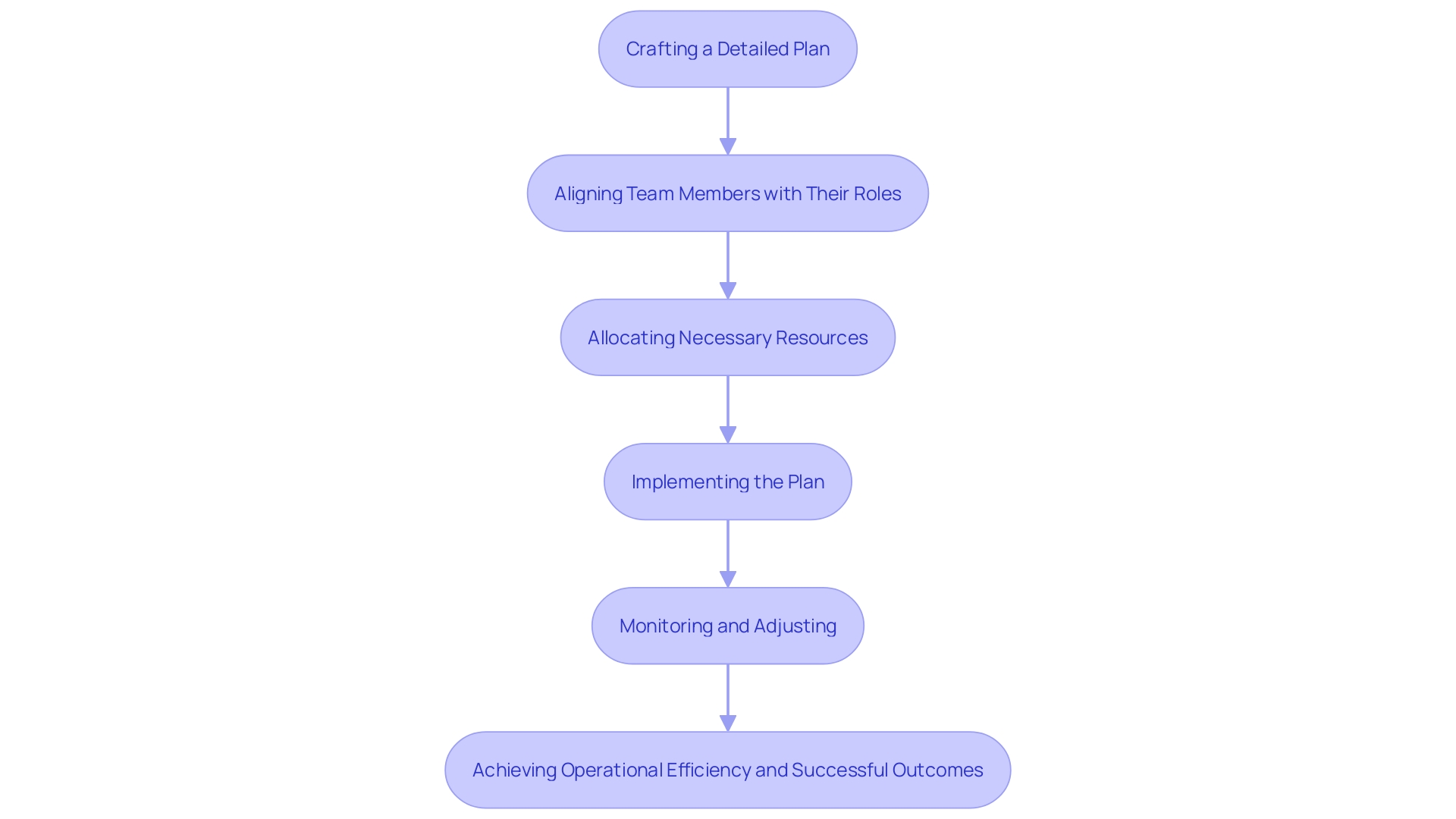
Step 6: Bot Development and Integration with Existing Systems
After finalizing the planning phase, the next step is to initiate bot development. Collaborate closely with technical teams to ensure seamless integration of bots with existing systems. This is crucial for maintaining operational continuity and avoiding disruptions. Focus on developing user-friendly bots that demand minimal intervention, thus enhancing productivity and reducing the time spent on manual tasks.
A key consideration during development is the complexity of integrating multiple systems and services. For instance, Lindy, an AI assistant designed for tasks like medical scribing and customer support, faced significant challenges in integrating a large network of apps and services. This procedure required extensive research, planning, and development time, which threatened to delay their market entry by up to a year. To mitigate this, Lindy used n8n, a workflow automation tool, to streamline these integrations.
Moreover, the progress in AI and machine learning has led to more functional and smarter bots. These advancements enable bots to provide instant and efficient user interactions, automate customer service tasks, and deliver personalized content. However, the complexity of human language and context nuances still pose challenges. Specialized AI agents, designed to excel in specific domains, are proving to be an effective solution. These agents can leverage the strengths of existing AI technology while bypassing many of its limitations.
Integrating these insights into the development stages can significantly improve the effectiveness and efficiency of your bots, ensuring they meet the evolving needs of your organization.
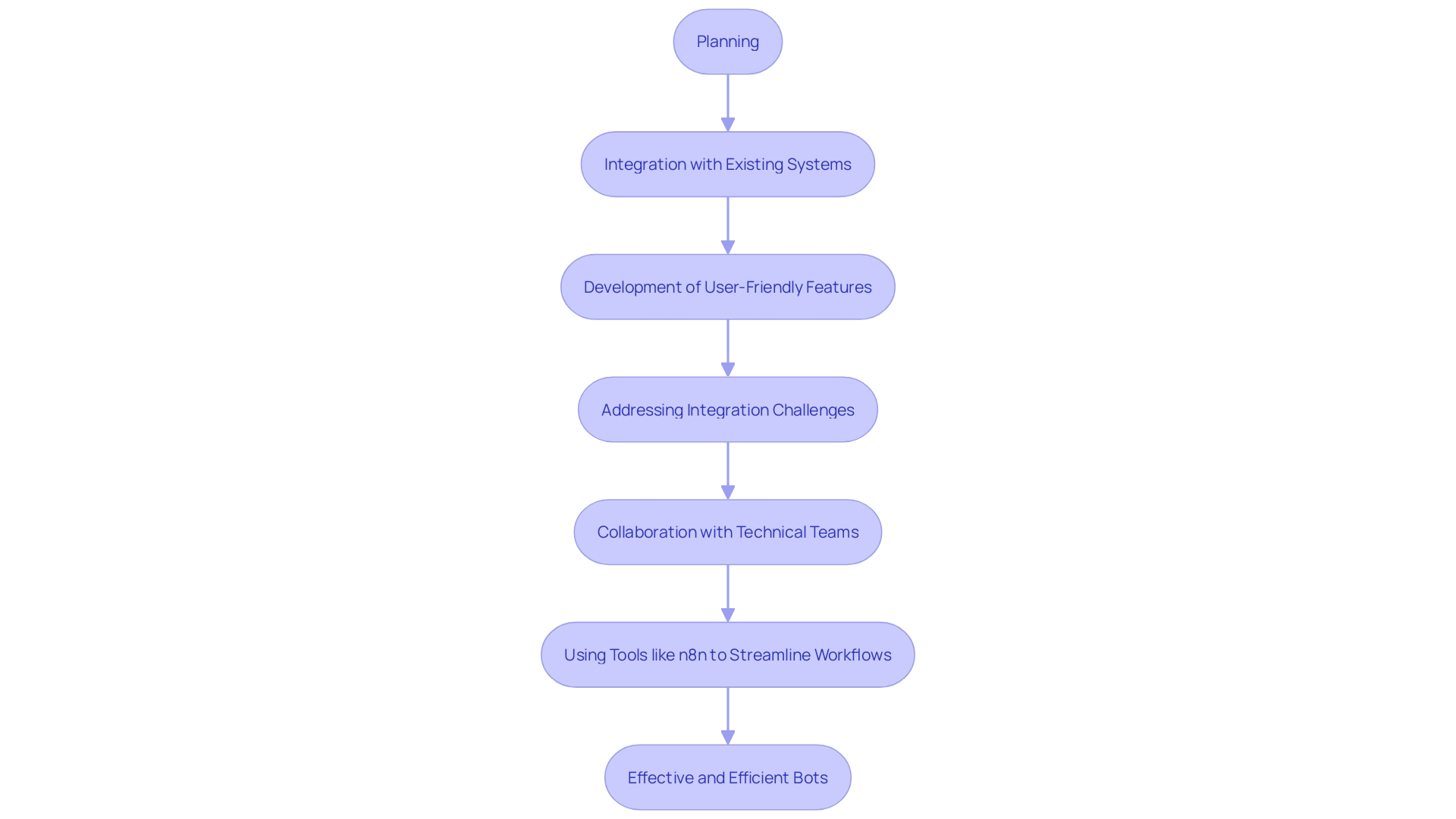
Step 7: Testing and Validation
Following the development stage, it is essential to carry out comprehensive testing to confirm that robotic task bots operate as expected. Rigorous validation involves simulating real-world scenarios to assess both functionality and accuracy. Additionally, using advanced simulations, such as those highlighted by the RialTo system, can help train robots effectively in physical spaces, ensuring they operate seamlessly once deployed.
Addressing any issues uncovered during these tests is essential for smooth deployment. According to the World Quality Report, quality assurance teams must ensure that software testing keeps pace with rapid innovation to avoid obsolescence. This perspective shift—from viewing testing as a cost center to recognizing it as a significant contributor to cost savings and ROI—underlines the importance of robust testing protocols.
ABB’s approach to deploying versatile collaborative robots worldwide demonstrates the importance of a well-executed testing phase. Their robots are designed to work safely alongside human operators, combining human adaptability with robotic precision. This ensures the assembly of various products on the same line, highlighting the benefits of thorough pre-deployment testing.
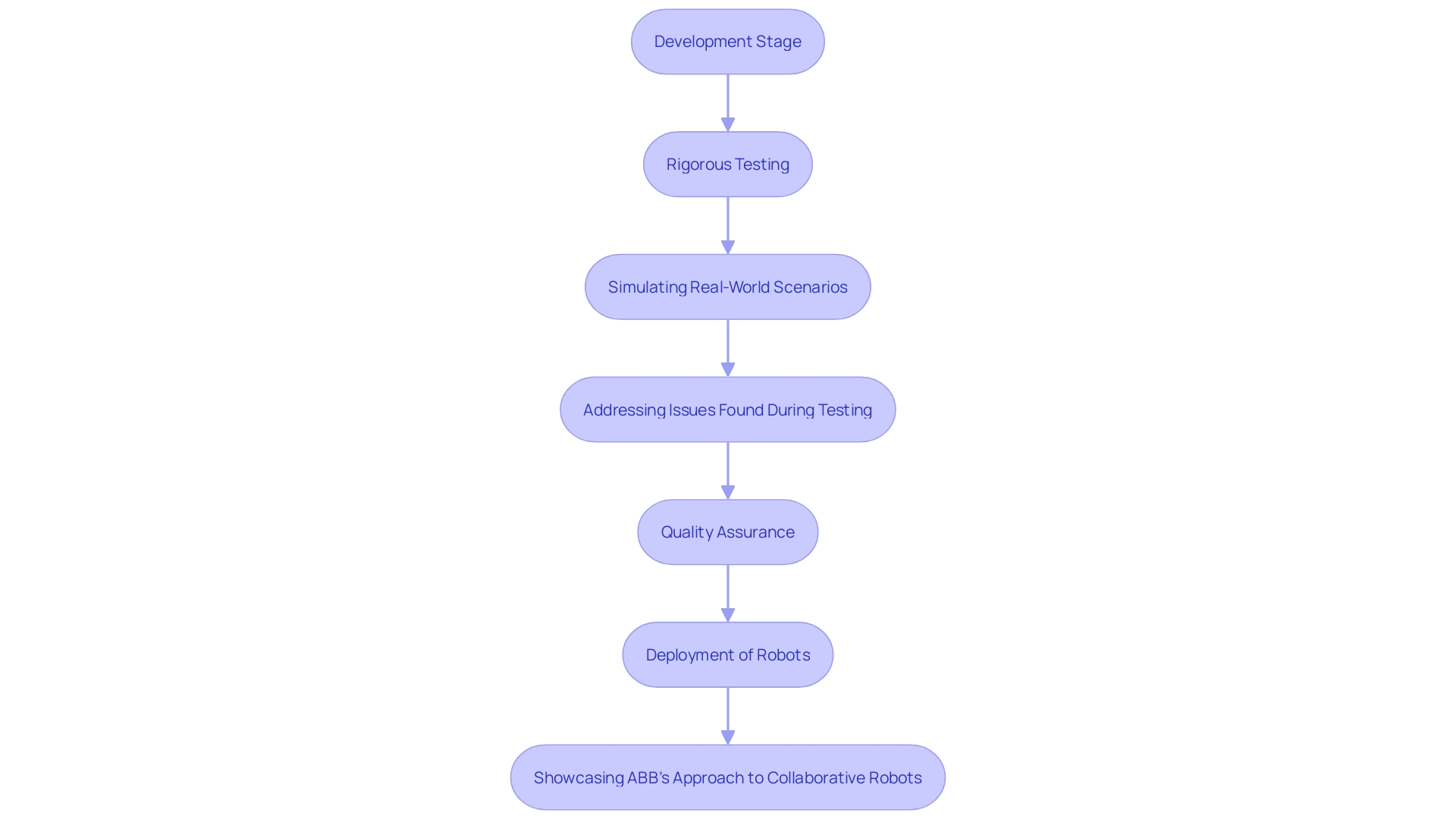
Step 8: Security and Compliance
Implementing robust security measures is crucial to protecting sensitive data and ensuring compliance with industry regulations. Conduct dynamic risk assessments to identify potential vulnerabilities and adopt security best practices for your RPA solution. According to Fouad Khalil, Senior Director of Enterprise Security, Risk, and Compliance, the increase in cyber threats such as ransomware and phishing attacks necessitates that security is essential to any system implementation, particularly in crucial areas like warehousing and logistics.
The introduction of the NIS2 Directive in 2022 further underscores the importance of stringent security measures. This directive expands coverage to essential sectors, including telecommunications and manufacturing, and imposes stricter security requirements for risk management and supply chain security. It highlights the necessity for organizations to adopt comprehensive security strategies tailored to their operations.
Real-world examples emphasize the significance of maintaining robust cybersecurity. For instance, the largest healthcare data breach of the year affected over 11 million individuals, illustrating the devastating impact of inadequate security measures. This breach serves as a stark reminder that safeguarding sensitive information is vital to maintaining trust and avoiding legal repercussions.
Incorporating these security measures not only protects your organization but also fosters a culture of trust and resilience. As the cybersecurity workforce continues to grow, with an estimated 4.7 million professionals globally, staying updated on the latest trends and threats is essential. Only 4% of organizations feel confident in their security, indicating a significant need for continuous improvement and vigilance in protecting against cyberattacks.
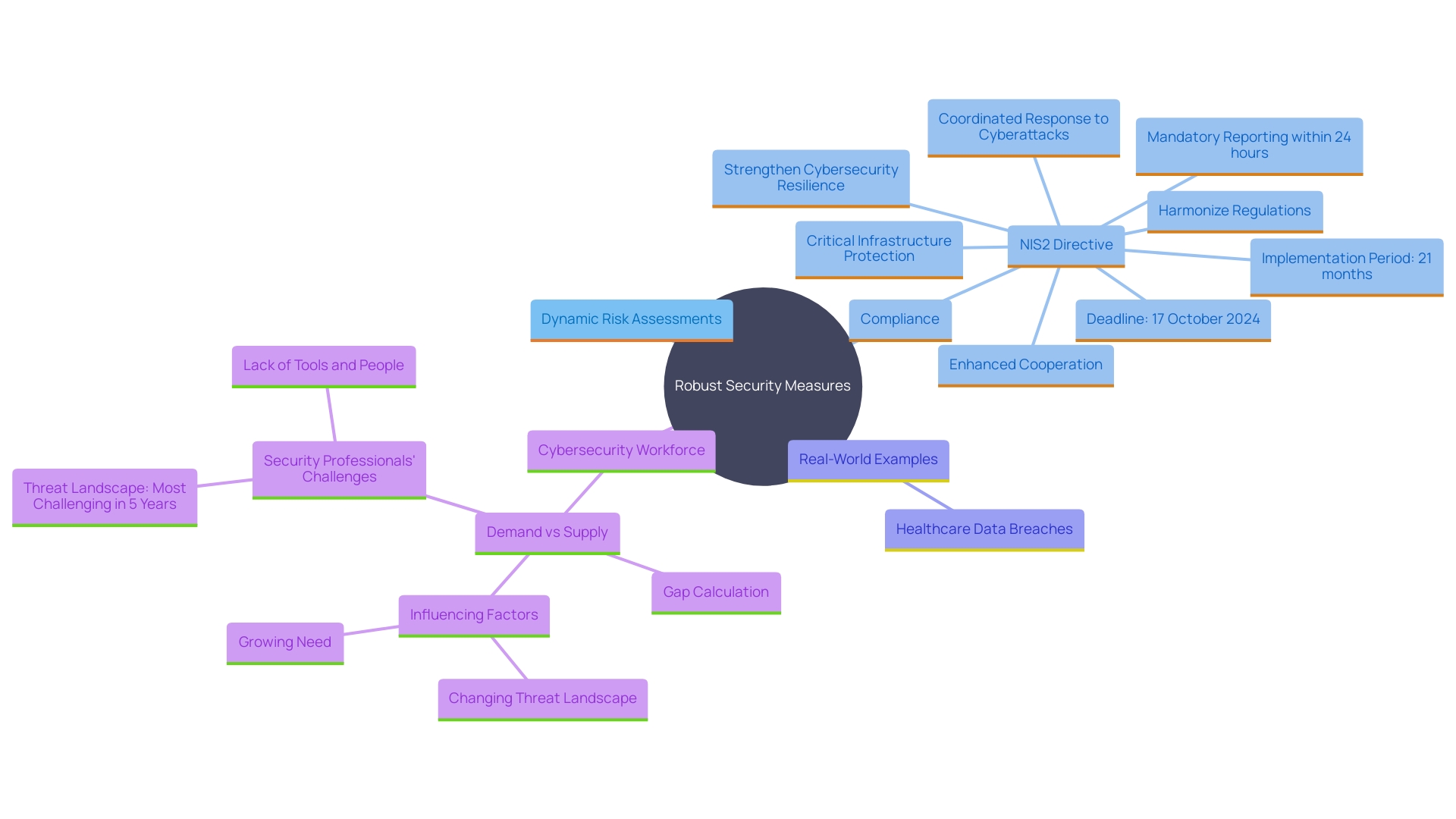
Step 9: Training and Change Management
To fully harness the benefits of Robotic Process Automation (RPA), prioritizing comprehensive training programs for employees is essential. This involves not only equipping them with the necessary skills but also fostering an environment that welcomes change. Implementing effective change management strategies can significantly ease the transition, addressing resistance and ensuring smooth adoption.
Engaging employees from the outset can help mitigate fears associated with new technologies. As Rosabeth Moss Kanter of Harvard Business School notes, understanding the root of resistance often reveals underlying anxieties rather than outright opposition. Encouraging a mindset shift towards continuous learning can transform apprehension into enthusiasm.
Working together is essential in this endeavor. By ensuring that all team members are on the same page and understand the value of automation, organizations can foster a culture of innovation and efficiency. As observed in the NHS Digital Service Team’s strategy, conducting thorough assessments and understanding existing capabilities within the organization can streamline the adoption phase, preventing duplication and maximizing resource utilization.
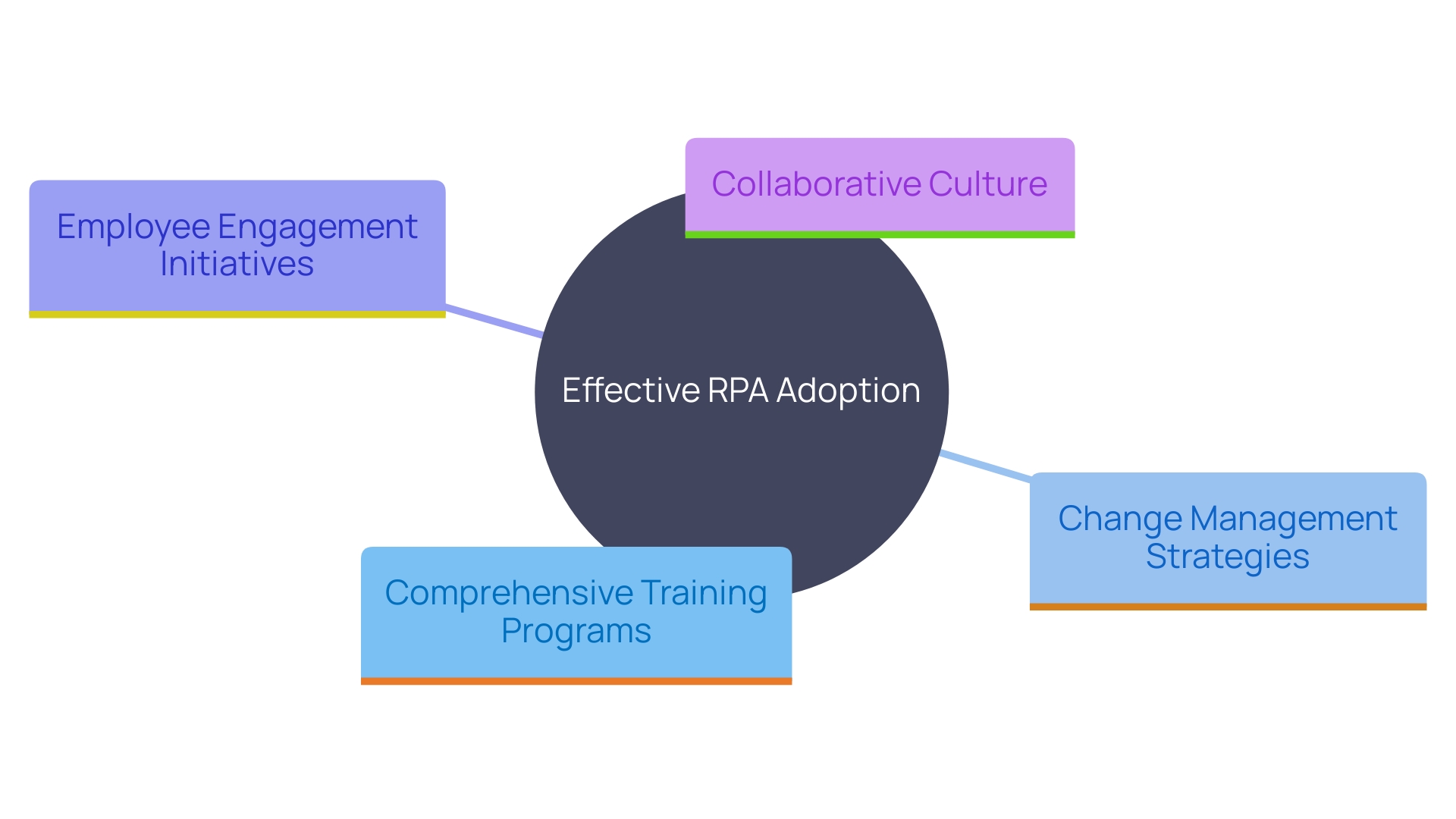
Step 10: Pilot Deployment and Scaling Up
Once the testing phase is completed and the staff are adequately trained, the next step is to initiate a pilot deployment. This phase is crucial for observing the real-world performance of the RPA system. Regular observation during this phase enables the gathering of important feedback, which is crucial for implementing necessary modifications to enhance the system.
If the pilot deployment proves successful, the focus should shift to scaling up the RPA implementation across other departments. ‘This multi-stage approach reflects the broader digital transformation journey, which includes digitization, digitalization, and ultimately, full digital transformation.’. Each step utilizes enhanced data collection and examination to improve organizational productivity and decision-making.
By placing technology at the core of process execution, organizations enable their human workforce to concentrate on delivering high-value expertise, thereby creating additional value for all stakeholders involved. This methodical approach ensures not only the stability of the RPA system but also its alignment with the long-term strategic goals of the organization.
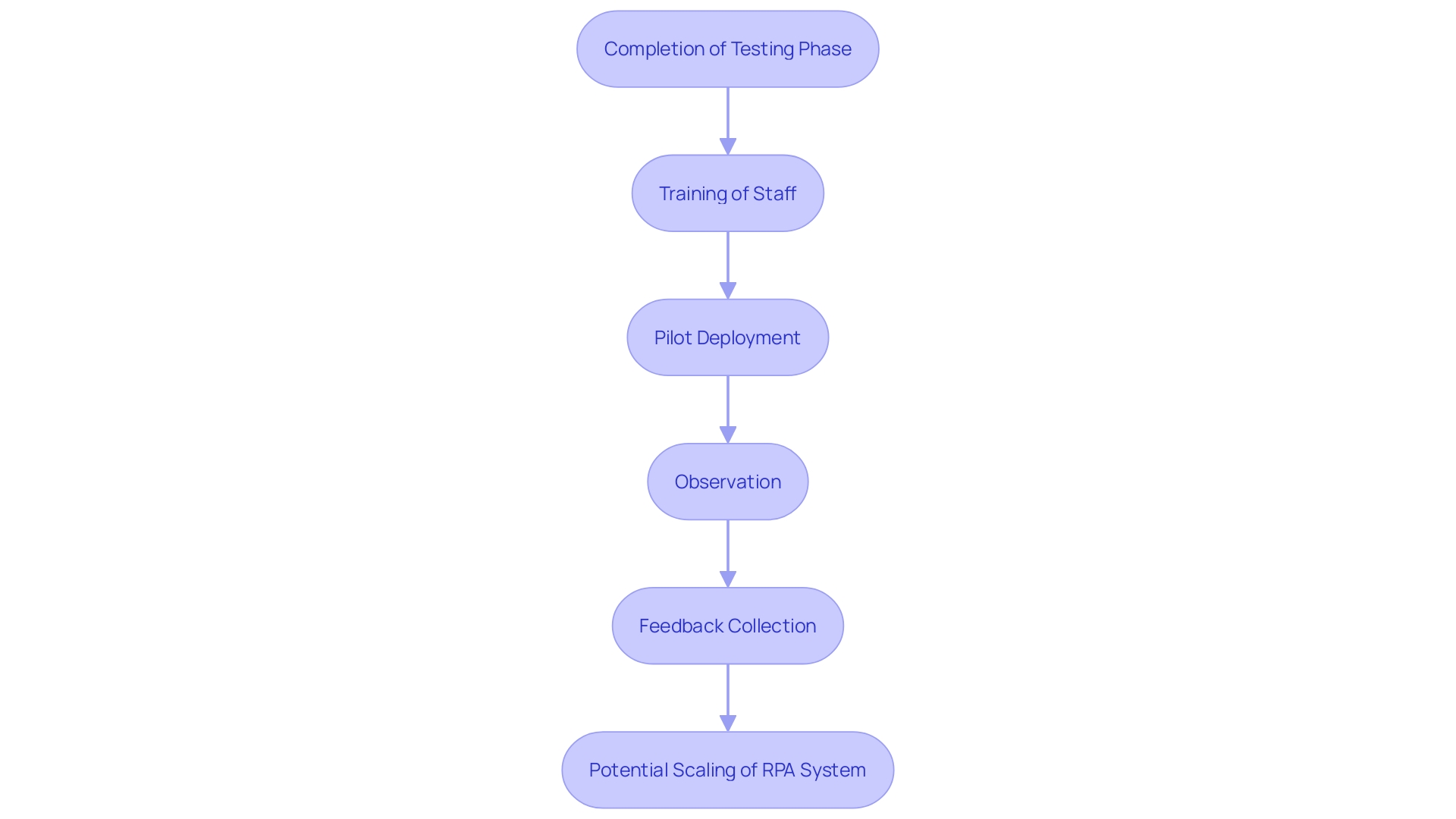
Step 11: Monitoring and Maintenance
To ensure your RPA bots operate efficiently, continuous performance monitoring is essential. Establish robust maintenance protocols to promptly address any issues, minimizing downtime and operational disruptions. The case of Medien Hub Bremen-Nordwest illustrates the significant benefits of proactive monitoring and maintenance. By collaborating with Parloa and SC Soft, they exceeded their goals and drastically reduced customer complaint processing times.
Unplanned downtime can be a costly setback for businesses. Traditional approaches to fixing robot downtime are not only inefficient but also expensive. As noted by Express Computer, the costs associated with such downtimes can be prohibitive for small and medium-sized enterprises (SMEs). By implementing a proactive maintenance strategy, you can avoid these pitfalls and optimize performance.
Automation, including RPA, has always needed human supervision to ensure stability and effectiveness. As highlighted by the CTO of Reveille Software, “Automation was never created to be hands-off.” Regular monitoring and management are essential for maintaining operational effectiveness and achieving long-term success.
In the case of Rippling, moving to a more robust AI agent solution significantly enhanced response accuracy and productivity. Their previous system required heavy manual oversight, limiting scalability. This shift underscores the importance of continuous system evaluation and upgrading to meet evolving business needs and maintain high performance.
The predictive maintenance market offers a strategic approach to monitoring industrial equipment, predicting failures, and optimizing maintenance efficiency. This approach not only promises significant cost savings but also enhances asset performance. By leveraging predictive maintenance techniques, businesses can ensure their RPA bots and other automated systems run smoothly and efficiently.
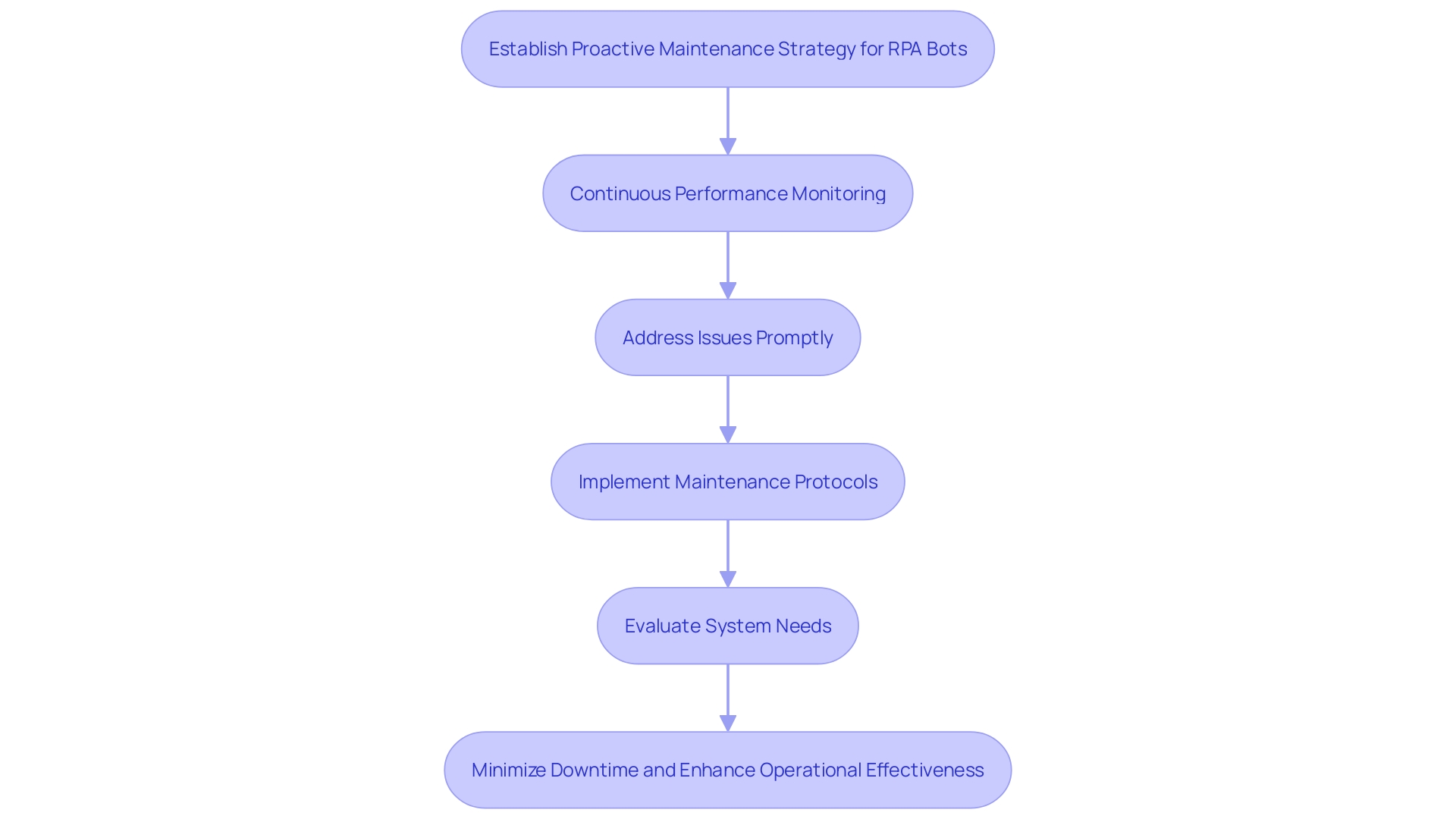
Step 12: Continuous Improvement and Reporting
Foster a culture of continuous improvement by consistently evaluating the performance and outcomes of your RPA initiatives. Utilizing data analysis is essential for monitoring success indicators, which not only emphasizes areas of achievement but also reveals additional opportunities for mechanization. Regular reporting is essential, as it provides stakeholders with clear insights into the impact of RPA on the organization. This method reflects the proactive strategies observed in other sectors, like the Mass General Brigham hospital system, where automation greatly enhanced data gathering and workflow activities. As Mark Twain aptly put it, “The secret of getting ahead is getting started.” By establishing a strong foundation in RPA, organizations can shift from reactive to predictive strategies, ensuring sustained efficiency and productivity gains.
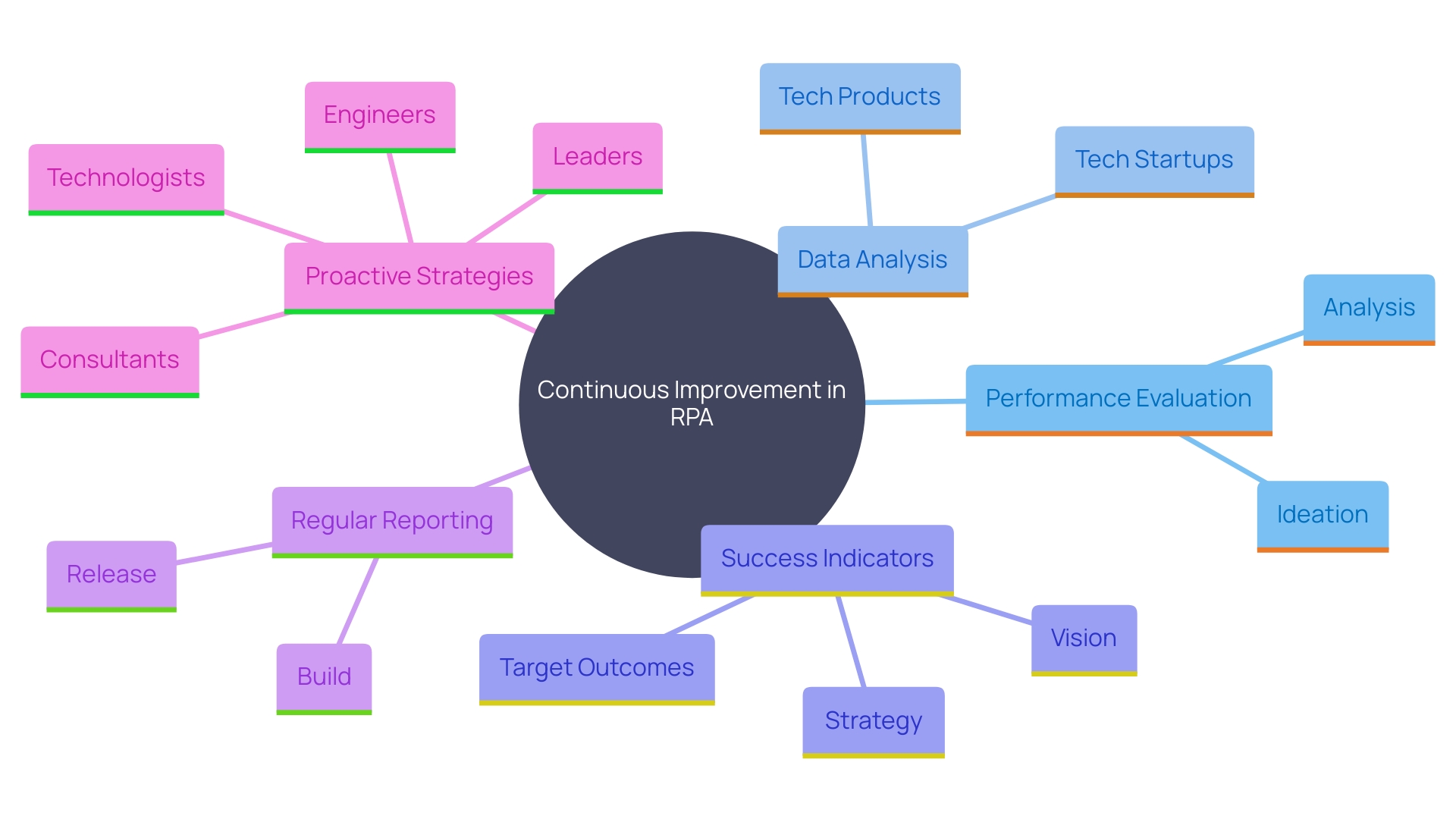
Best Practices for Successful RPA Implementation
Start by identifying the processes and stakeholders involved. Outline the systems, like inventory management and online shop software, to identify possible candidates for mechanization. Prioritize tasks based on complexity and expected ROI, focusing on low-complexity, high-impact tasks for quick wins. For instance, many companies have successfully automated identity verification and order inquiries, significantly improving efficiency.
Involve stakeholders from the beginning to ensure buy-in and smooth implementation. Clear communication is key to overcoming resistance and ensuring everyone understands the benefits and tradeoffs of automation. Establish guiding principles for selecting the right technologies, understanding the nuances within each category, and evaluating vendor options.
Providing ongoing support is crucial. Automation isn’t a hands-off process; it requires continuous monitoring and management. As the CTO of Reveille Software notes, even with advanced technologies like AI, human partnership is essential to maintain stability and drive success. By adhering to these best practices, you can effectively implement RPA and achieve substantial operational improvements.
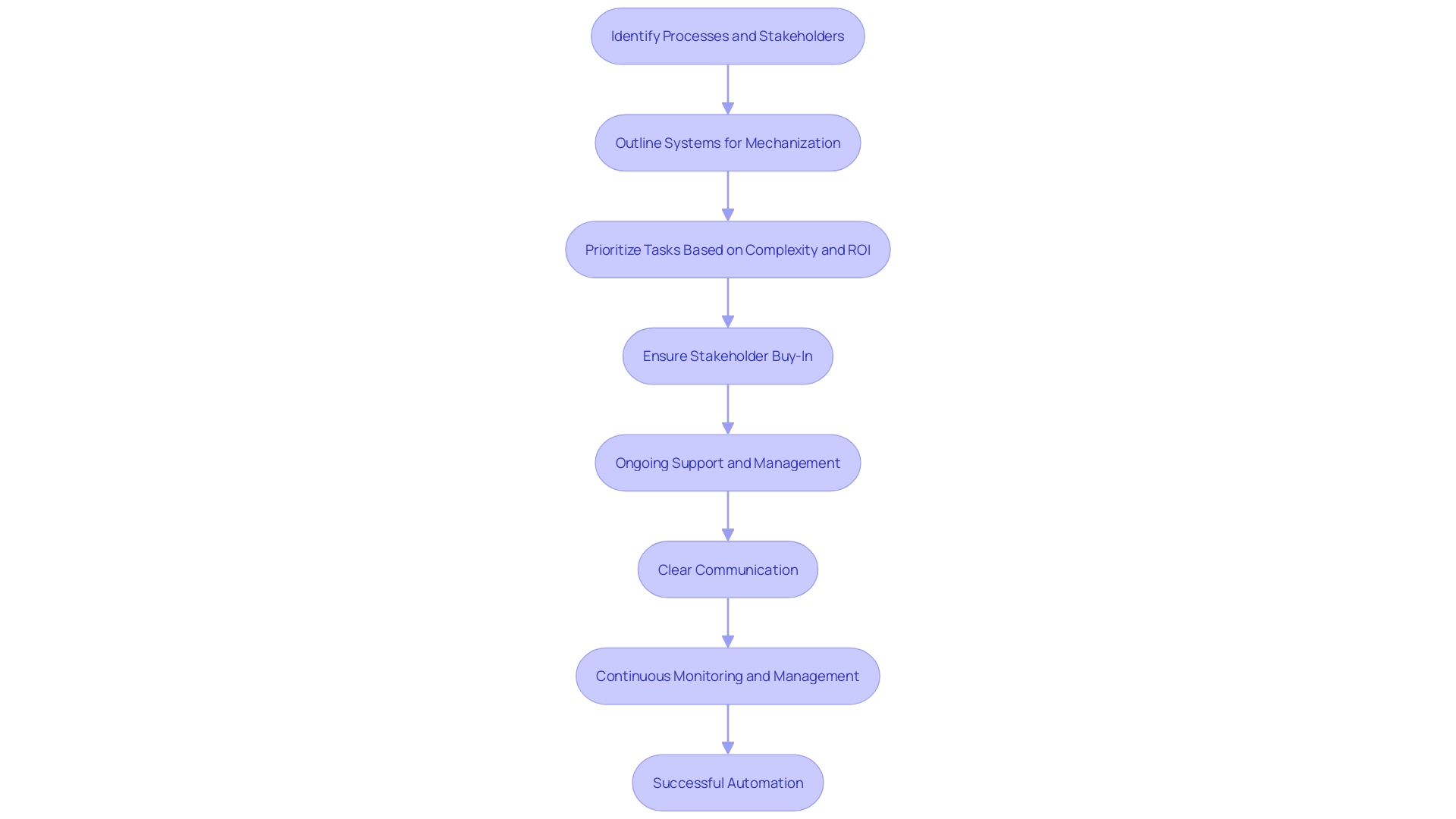
Common Challenges and How to Overcome Them
Navigating common challenges such as employee resistance, integration issues, and data quality concerns requires a multifaceted approach. Fostering a culture of innovation is essential, as trust and engagement are pivotal for successful digital transformation. As Jeremie Brecheisen notes, initiating a cultural shift is crucial when integrating AI, emphasizing the need for trust between leaders and employees. Additionally, robust testing and maintaining high data standards are critical to overcoming integration and data quality obstacles. Digitization, digitalization, and digital transformation are interconnected steps where technology enables humans to focus on high-value tasks, enhancing overall operational efficiency. Embracing these strategies will ensure a smoother transition and greater acceptance of new technologies.
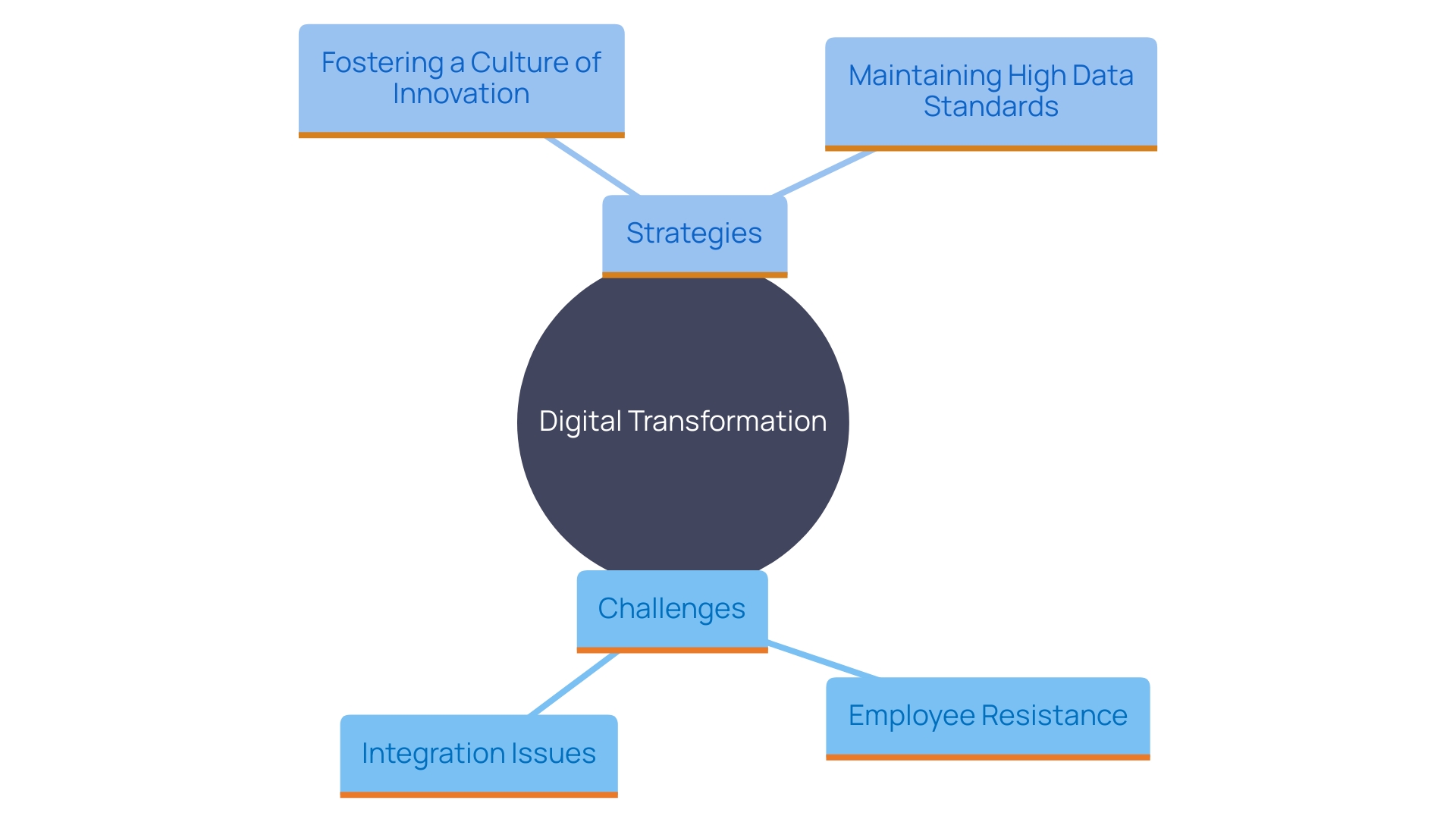
Conclusion
Successful implementation of Robotic Process Automation (RPA) hinges on a structured approach that addresses each critical step outlined in the roadmap. Defining clear objectives and selecting the right tools set the foundation for optimizing processes. Engaging stakeholders and thoroughly assessing potential opportunities ensure that automation efforts align with organizational goals and yield high-impact results.
Pilot testing and a phased deployment strategy are essential for mitigating risks and validating the effectiveness of RPA solutions. Continuous monitoring and proactive maintenance further enhance operational efficiency, while robust security measures safeguard sensitive data and ensure compliance with regulations. Training programs and effective change management strategies are vital in fostering a culture that embraces automation.
Ultimately, the journey toward automation is an ongoing process of continuous improvement. By leveraging data analytics and regularly reporting on performance metrics, organizations can identify new opportunities for automation, driving further operational enhancements. Embracing these best practices not only maximizes the benefits of RPA but also positions organizations to thrive in an increasingly competitive landscape.
The commitment to innovation and efficiency will unlock unprecedented potential, paving the way for long-term success.

